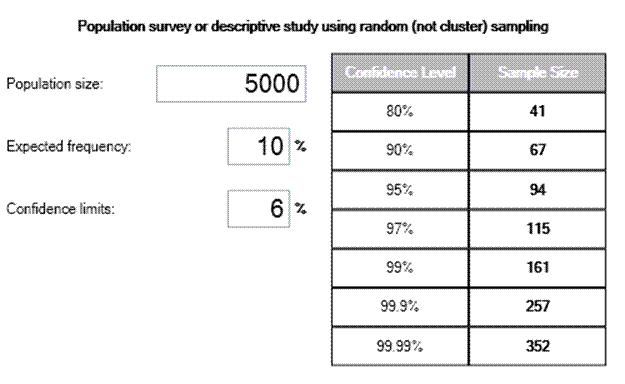Epi Info™ User Guide
StatCalc
How to: Population Survey or Description Study
Assumptions
- The sample to be taken must be a simple random or representative. A systematic sample (e.g., every fifth person on a list) is acceptable if the sample is representative. Choosing every other person from a list of couples, however, would not give a representative sample because it might select only males or only females.
- The question being asked must have a Yes-No or other two-choice answer, leading to a proportion of the population (those answering Yes) as the final result.
Example
Suppose you want to investigate whether the true prevalence of HIV antibody in a population is 10%. A random or systematic sample of the population is planned to estimate the prevalence. A 95% confidence that the true proportion in the entire population will fall within the confidence interval calculated from the sample is desired.
In StatCalc, enter the population size of 5,000, the estimate of the true prevalence 10%, and 10% as the Confidence Limit.Worst Acceptable value. The application will show the sample size for several different confidence levels including the desired 95%.
- From the StatCalc application main page, select Sample size & power. The following calculation options appear: Population survey, Cohort or cross-sectional, Unmatched case-control.
- Select Population Survey. The Population Survey or Descriptive Study Using Random (Not Cluster) Sampling window opens.
- Enter the Population Size of 5,000.
- Enter the Expected Frequency of 10%.
- Enter the Confidence Limits as 6%.
The results appear in the window.

Notes
Sample size determination is only a rough guide, based on assuming a specific value for the true population proportion, the variability in the sample estimate and its confidence limit. Many other factors (i.e.,cost, number of available subjects, rate of nonresponse, and the accuracy of answers and data transcription) must be considered in study design.
- Page last reviewed: December 23, 2015
- Page last updated: June 6, 2012
- Content source:


 ShareCompartir
ShareCompartir